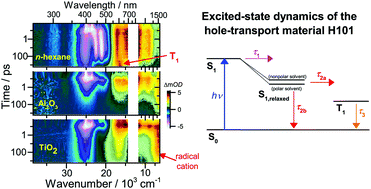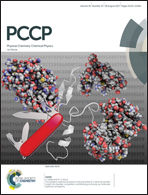Photoinduced dynamics of the hole-transport material H101 in organic solvents and on mesoporous Al2O3 and TiO2 thin films†
Abstract
We present a comprehensive steady-state and time-resolved UV-Vis-NIR absorption and fluorescence study of the hole-transport material H101 to characterise its photophysics in different organic solvents and on mesoporous Al2O3 and TiO2 thin films. Photoexcitation of H101 at 400 nm in organic solvents populates the S1 state which shows intramolecular relaxation on a picosecond time scale. Branching from the relaxed S1 state leads to population of the T1 triplet state and the ground electronic state S0. Triplet formation is induced by the internal heavy-atom effect of the sulphur atom, and the triplet yield decreases substantially with solvent polarity. On mesoporous Al2O3, intermolecular exciton-splitting is observed leading to the formation of a radical cation – radical anion pair (H101(S1) + H101(S0) → H101˙+ + H101˙−) followed by exciton recombination. On mesoporous TiO2, efficient electron injection is observed in addition to exciton-splitting. Complementary spectroelectrochemistry experiments enable a full spectral characterisation of the cation species H101˙+ and H1012+. Extensive DFT/TDDFT calculations successfully assign the spectral features of all experimentally observed species. Implications for the function of H101 in photovoltaic devices are discussed.



 Please wait while we load your content...
Please wait while we load your content...